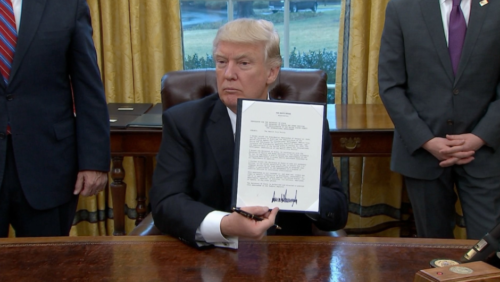By Zenani Orengo, Contributing Editor
On January 23rd 2017, President Donald Trump withdrew from the Trans Pacific Partnership (TPP.) Trump’s anti-trade rhetoric during his campaign resonated with disaffected voters who lost jobs in the manufacturing industry. Trumps withdrawal from the TPP fulfilled a campaign promise that he previously highlighted would help ‘negotiate fair, bilateral trade deals that bring jobs and industry back onto American shores.’ Unfortunately, Trump’s protectionist policies such as the withdrawal from the TPP are likely to cause more harm to the American economy than good.
The TPP aimed to eliminate 18,000 tariffs levied on American imports and exports. The agreement would bring together 12 countries (excluding China) that represent approximately 40 percent of the global economy. The TPP would allow the USA to help negotiate and set the rules on issues ranging from labor, intellectual property and environmental protections. In this way, America would level the playing field for American business and workers.
Although free trade policies are associated to job loss in the manufacturing industry, free trade deals were not the causation of job losses in the manufacturing industry. Instead, factors such as advancement in technology, increase in productivity and shifts in consumer tastes are the chief culprits in the shrinking of manufacturing employment and the growing disparity in the wage gap.
Indeed, cheap imports are harmful to higher pay in the manufacturing industry, but they are not mutually exclusive. The main contention against lowering tariffs is that increasing imports from poorer countries (that have a comparative advantage in hiring unskilled labor) drive local prices down. Lower prices from goods and services produced in poorer countries compete with the unskilled labor market in the United States, forcing factories to close down, slash payrolls and/or outsource in order to drive production costs down. Loss of jobs in manufacturing is guaranteed with or without trade policies as new technologies increase productivity. In fact, most factories have returned to American shores however the jobs have not. Labor has now been replaced with heavily automated machinery accompanied by few skilled workers to operate the machines. In light of this, there will be no great manufacturing renaissance.
In the 1992 presidential debate, independent candidate Ross Perot postulated that sending jobs overseas by way of NAFTA (North-American Free Trade Agreement) would result in “a giant sucking sound south.†This sound was never heard. NAFTA was ratified in 1993 during Bill Clintons administration, the tripartite agreement eliminated tariffs between the US, Mexico and Canada. Critics of NAFTA predicted that US industry would lose jobs to Mexico, while proponents argued that exports would offset the negative effects of cheap imports. This was evidently true, trade created new markets for American firms. As a result, the unemployment rate steadily decreased from 6.9% in 1993, 5.4% in 1996 and 4.0% in 2000.  Clearly trade policies are not the cause of job loss as postulated by Trump.
The simple fact remains, critics will present data that is disproportionately representative of the negative effects of free trade agreements such as NAFTA. Critics will posit that increase in imports are bad because they result in higher trade deficits. While in reality trade deficits depend on the health of the economy, if the economy is growing trade deficits will be high because consumers have a higher disposable income to purchase cheap imports. It would be a sweeping generalization to assess the effectiveness of trade policies on the merits of trade surpluses or deficits.
NAFTA teaches two very important lessons when analyzing free trade policies. First, not to demonize the costs of free trade. Second, to accept that costs will always arise from free trade.
Although the TPP is a trade agreement, the benefits that arise are far-reaching. US trade representative, Michael Froman emphasized “while you don’t get to vote on globalization, trade agreements are how you shape globalization.†The key implicit benefit that arises from the TPP is that it squarely positions the United States against China in her own backyard. In an op-ed, former President Barack Obama put forward a national security argument. Emphasizing that “when we bind our economy closer to others in a strategically important region, America is both stronger and safer†forewarning that “the Asia-Pacific region will continue with integration with or without the United States.†In this way, the TPP sought to drive a wedge in China between what should be its strong hold by working towards diverting economic activity away from China.
Finally, if the TPP were ratified would we have heard that proverbial “sucking sound†east?  The simple answer is no. China exists and will continue to exist and compete in the global economy. If the US fails to integrate in global economies, it diminishes its potential to expand its market share in thriving industries and also compromises the role of the American president outside the United States.
Zenani Orengo is a first year student at the Robert F. Wagner Graduate School of Public Service pursuing an International policy specialization. Zenani has previously worked as a Communications Intern at the International Center for Transitional Justice in New York. Zenani is also a Contributing Editor at the Wagner Review




